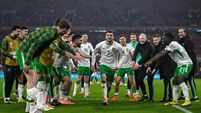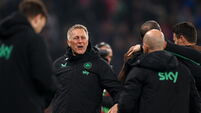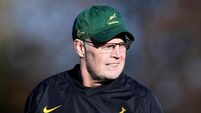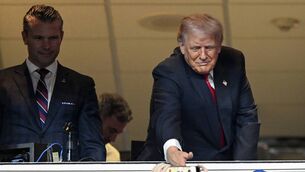Jack B Yeats painted sport right at the centre of life
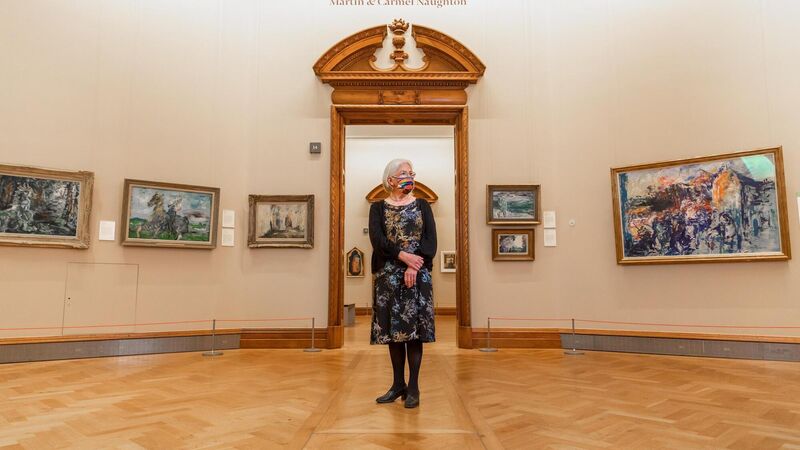
The National Gallery of Ireland’s newest exhibition – ‘Jack B. Yeats: Painting & Memory’ – opened in September. Happily supported by Key Capital, the opening of the largest exhibition of Yeats’s oil paintings in 50 years coincides with the 150th anniversary of the birth of one of Ireland’s most important artists. Pictured ahead of the exhibition’s opening is the artist’s grandniece, Caitriona Yeats.
Jimmy Magee provided the soundtrack to some of the most brilliant moments in Irish sport. He rarely failed to capture the emotion of a moment.
And so it was when John Treacy turned around the track in the final yards of the Los Angeles Olympic Games in 1984.
Carlos Lopez from Portugal had already won the gold medal (his country’s first ever Olympic gold medal) and Britain’s Charlie Spedding was trailing Treacy in the race for the silver medal.
As Treacy pulled away from Spedding, Magee got emotional and ran through the roll-call of previous Irish Olympic medalists. There was O’Callaghan and Tisdall and Delany and McCourt and Tiedt. All runners and boxers and weight-throwers and sailors.
All had won their medals after the founding of the Irish Free State.
Magee obviously chose not to list the many men – including all-time greats, internationally recognised as such, like Martin Sheridan and Tom Kiely – who had won Olympic medals in the years before 1921, some in the colours of America, others representing Britain and South Africa, or just representing themselves.
But he also failed to list the earliest winner in the history of the Irish Free State: the silver medal won by Jack B. Yeats at the 1924 Paris Olympics for a painting entitled, ‘The Liffey Swim’, Dublin’s iconic swimming race.
These were the years when artistic works were considered important aspects of Olympic competition.
You can’t say this about any other Irish Olympic winner, but every week in Dublin you can bear live witness to an actual Olympic-winning performance. Just walk (for free) into the National Gallery and ‘The Liffey Swim’ hangs, in all its glory, near the entrance.
Yeats can rightly be claimed as the greatest painter in Irish history. There is a magnificent exhibition of his work now running at the Gallery. The exhibition is of his oil paintings and is timed to mark the 150th anniversary of his birth.
What this exhibition makes clear is that sport played a central part in the life of Yeats, and in his work. This should be no surprise: in the late 19th century, when Jack Yeats grew into adulthood and into the genius of a career as an artist, the modern sporting world was being constructed. This world runs through his life’s work, sometimes dominant in the centre of pictures, other times it lurks in the background.
Central to his sporting scenes are boxing, horse racing and swimming. There are paintings of men swimming in the waters off Rosses Point in Sligo; these paintings link the world of informal swimming with the formal competition of ‘The Liffey Swim.’
The best of the sporting paintings are on boxing. Jack Yeats spent time living in London in the 1890s and 1900s. While he was there he went to boxing matches down in the East End. The old world of bare-knuckle fighting was still alive, but it now shared space with the newly organised sport of gloved amateur boxing. Yeats captured many aspects of this world, sketching the fighters, the officials, and capturing the crowd who attended. There is, in the current exhibition, a painting called ‘The Master of Ceremonies’, a man leaning on the red ropes of the ring, making an announcement, resplendent in evening dress and wearing white gloves. But boxers are also painted: Yeats admired them and their courage, and in short he loved their sport.
This love was what brought him to Donnelly’s Hollow in the Curragh in Kildare, the subject of another painting. It was here that the Irish champion Dan Donnelly had recorded his famous victories over English rivals back in the early 19th century.
This remains a mythic site in Irish boxing history. People visit it every day to see the monument to Donnelly and to see how the footprints he is supposed to have left as he departed the ring after the famous victory have been preserved in the grass.
There are also stunning paintings on horse racing. “Now or Never” shows a mounted jockey at the start of a race, with – as Donal Maguire and Brendan Rooney have written in their beautiful book of the exhibition – “drama and tension” everywhere visible.
The wider archive which the National Gallery holds of Jack B. Yeats – and the scale of his etchings in general – are further testimony to how his love of sport informed his work.
There’s “Cricket at Coole” which recalls the regular cricket matches played on the front lawn of Lady Augusta Gregory’s house, where the local aristocracy mixed with the servants of the house to make teams.
There are the sporting posters hanging on the walls of a Dublin barbershop, as a man sits in a chair with a new short, back and sides. There is a fortune-teller advertising her services at the Torquay Races. There’s a man fishing near a bridge in Kilea, County Donegal. There are great shooting days where men shot from the bans of lakes in Devon, while others shot standing up in boats. There’s a man doing a dance at Ardrahan Sports Day in County Galway in 1901.
And there’s great humour in it all. A rough sketch of a “grand parade of hurlers” behind a brass band in Jones’s Road Sports Ground in August 1902 (it was not known as Croke Park until 1913) includes the immortal line: “He says he’ll mow the head off that great eejit.”
It should be noted in passing that it may not be in art galleries that people look for sport. But this need not be the case. For example, the Portrait Gallery in London staged an exhibition of leading figures from the world of British sport, across several centuries. It drew huge crowds.
Similarly, a recent exhibition in Manchester tied together soccer and art. Household names and hidden gems hung side-by-side. And among the names of the painters on display were David Hockney, Banksy and L.S. Lowry.
Hockney’s “A Bounce for Bradford” depicted a football bouncing around, leaving lines and shadows in its wake. Banksy’s “Football Terrorist had previously been displayed as part of the “War, Capitalism and Freedom” exhibition in Rome in 2016 and is one of the graffiti-artists most iconic works.
The point is a simple one: sport offers galleries an opportunity to connect with people who may not usually be drawn through their doors. And the best of Irish artists understood just how central it was – and is – to everyday life.

